It is well known that ships are the greatest means of transport built by mankind. But how big is an ocean liner actually? After all, there are smaller and bigger ones among the ships. Well, until the advent of bulk carriers (eg tankers) and container vessels, ocean-going passenger ships were the largest vehicles on earth for almost one hundred and twenty years, and seemed almost unimaginably large for a land-based man, for whom the greatest means of transport was just a horse-drawn carriage in the past, and even these days it's just a truck at most. Nevertheless, of course, there were (sometimes considerable) differences in size between ocean liners. Comparative diagrams and comparisons (which make oceanliners conceivable by comparing them with ordinary objects also familiar to land people) informing the public about amazing dimensions of oceanliners, and small or large differences between them. They attempt to transfer information, data, or knowledge, typically without words, by means of visual representation, that is, according to our present-day concepts, they can be considered infographics. The writing of Dr. Tamás Balogh gives an introduction into their story and an overview of their types.
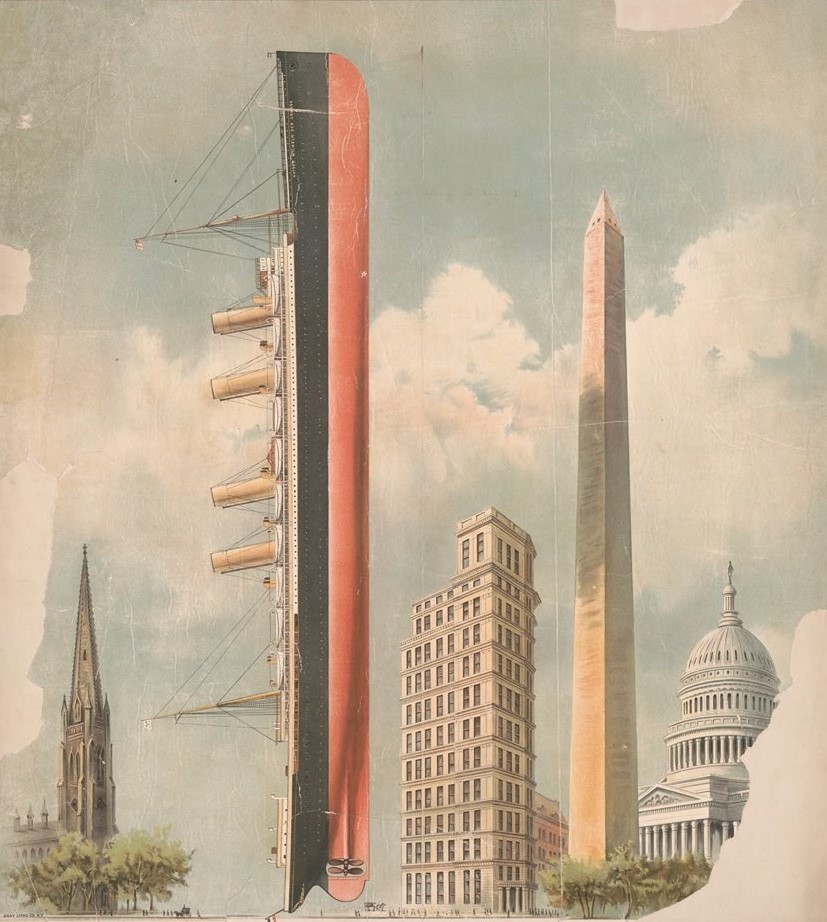
I.) The development of comparisons as an illustrative representation:
We don’t know exactly which was the very first comparative representation ever made for an ocean liner. In any case, the very first ocean liner, which dimensions were spectacularly surpassed any idea by, was the British GREAT EASTERN (1858-1890), designed by Isambard Kingdom Brunel and built by John Scott Russel at the dawn of the Industrial Revolution. The ship was six times the displacement of the largest vessel built until that (the GREAT BRITAIN, also designed by Brunel), and was almost unimaginably large compared to other contemporary ships.
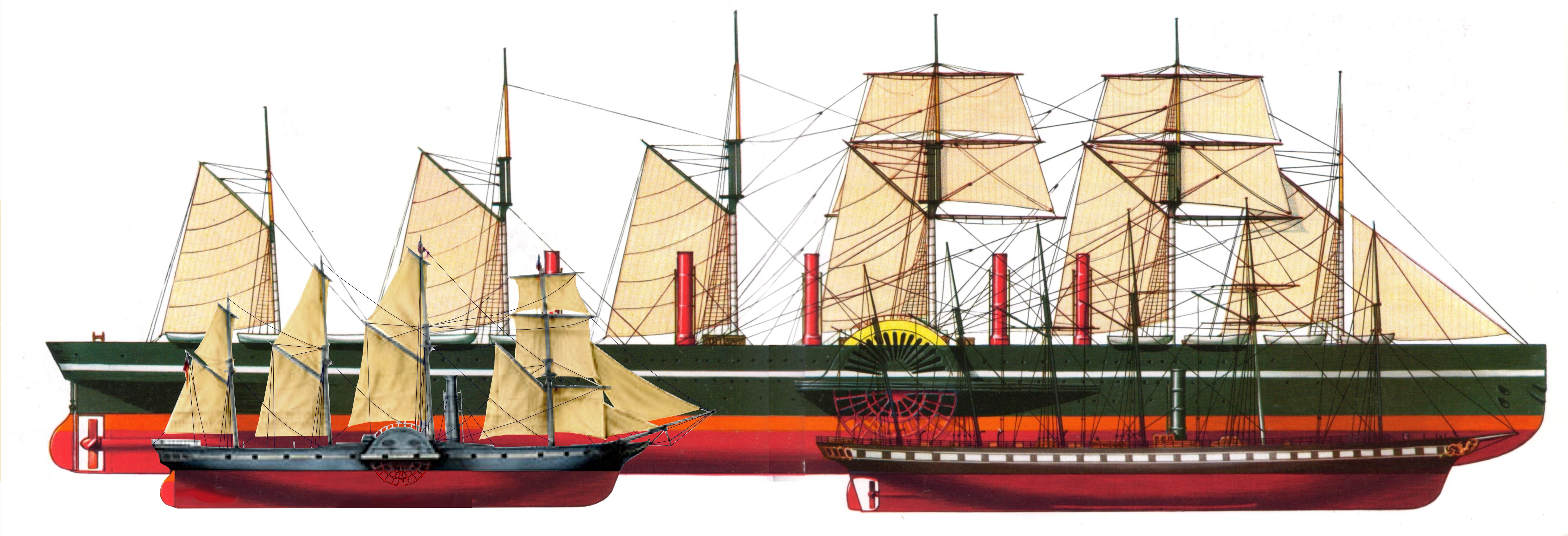
Figure 1: Scale representation of Isambard Kingdom Brunel's three revolutionary ships is a good illustration of the development of shipbuilding in the life of a single person (the picture was taken by Dr. Tamás Balogh using a drawing by Björn Landström). At the time, all three ships held a world record. Their designer - with the support of constructors who helped make the plans come true - became the father of all modern ocean liners, and his ships became the ancestors of the ocean liners known today. (Source of the original: Landström, Björn: The Ship, Doubleday, 1983.)
The GREAT WESTERN (in front left) was still built of wood. To cross the Atlantic with steam (the sails did not serve the propulsion, only helped to hold proper direction) had to build the largest hull in the world at the time in order to accommodate the abundant coal needed for the transatlantic voyage. For the proulsion, a surface condenser had to be invented to convert the exhausted steam of the engine into feed water again, and the largest wrought-iron shaft ever made for paddle wheels was needed to traversing the width of the huge hull (so the world's largest steam hammer had to be made for machining that).
The GREAT BRITAIN (in front right) was the largest ship of its time too. This was the first ocean liner made by wrought iron and the first which driven by a propeller (the sail here was not for propulsion either). To ensure the buoyancy of the ship in the event of any havaria, compartments with watertight bulkheads were built into hull for the first time.
And GREAT EASTERN (in the background) brought together all the knowledge that engineers and shipbuilders had acquired until then. At the same time, of course, she introduced further innovations: she was the first ocean liner to be built with a hull which had double bottom and - in partially - double side, making her not only an exceptionally large, but an exceptionally safe vessel (thanks to the built-in watertight compartments and watertight decks).
GREAT EASTERN was the number one technical sensation of her age, simultaneously awakening admiration and certain concern. It is no coincidence that after the huge biblical sea monster, she was originally named LEVIATHAN, and Jules Verne also wrote a novel entitled “A Floating City” (Une Ville flottante) as a result of his experiences on board. So we are hardly mistaken, if thought that the birth of comparative representation of ocean liners (which later became so popular) are in connection with the GREAT EASTERN.
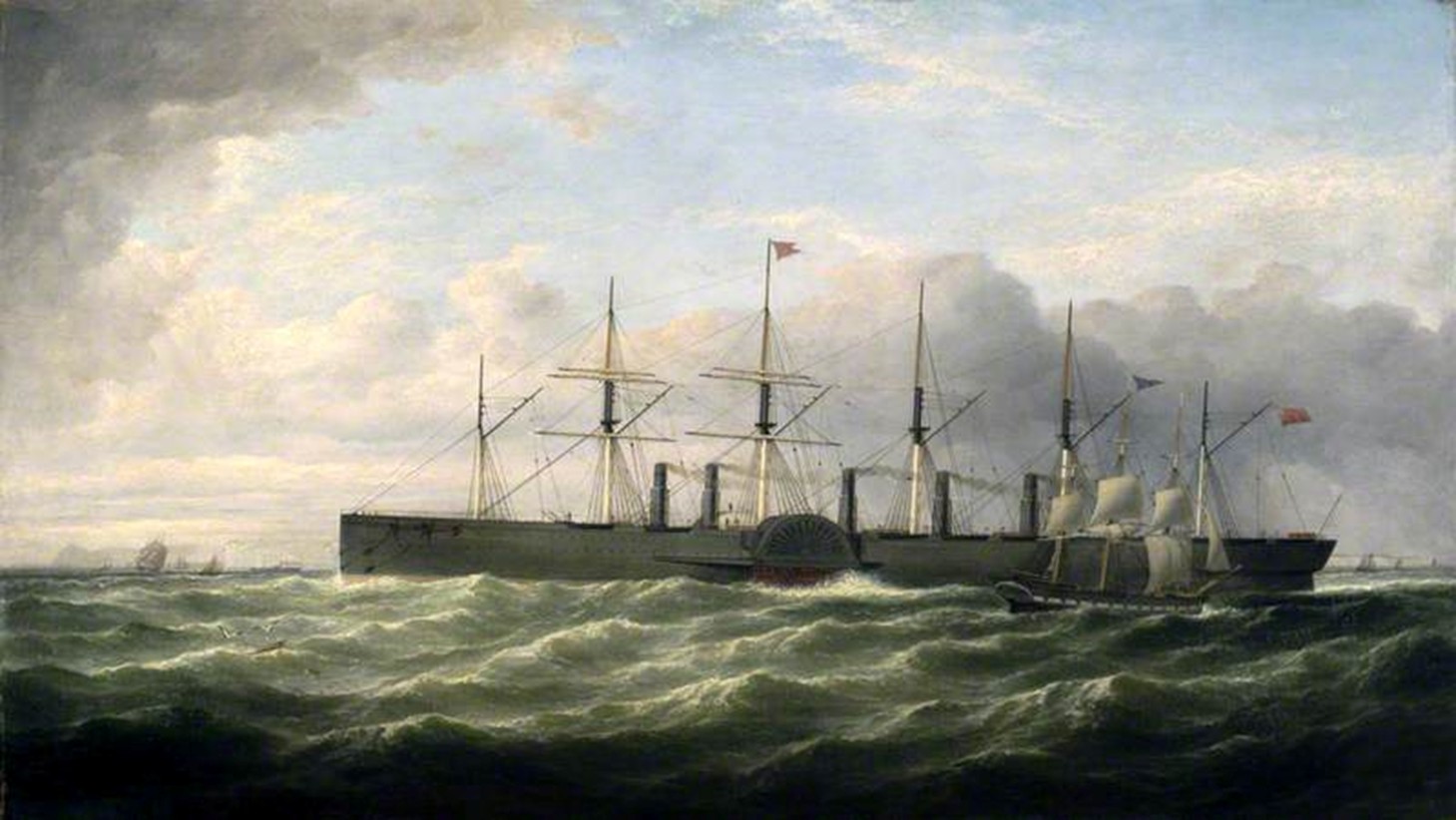
Figure 2: Probably all started like this: the huge dimensions of the ship at first made it possible to compare her with other ships of the age only in the paintings made of it. (Source: Weedon, Edwin - The Great Eastern pasing through the Downs, 1859. Science Museum, London)
The considerable difference in size between the GREAT EASTERN and the traditional sailing ships or the first steamers which seemed dwarf beside the giant, was a striking phenomenon clearly seen from all contemporary depictions of the ship, and has not escaped the attention of the contemporary press too. After all, every part of her was so incredibly large, compared to the usual sizes, that it was already a creepy thrill in itself. GREAT EASTERN's huge size and advanced technology have attracted so much interest that the optimism that followed her construction has spread to America after Europe, where the first announcements of the ship's dimensions have inspired several cartoons of her in local newspapers, during the construction (https://www.ibiblio.org/hyperwar/OnlineLibrary/photos/sh-civil/civsh-g/gt-est-x.htm).
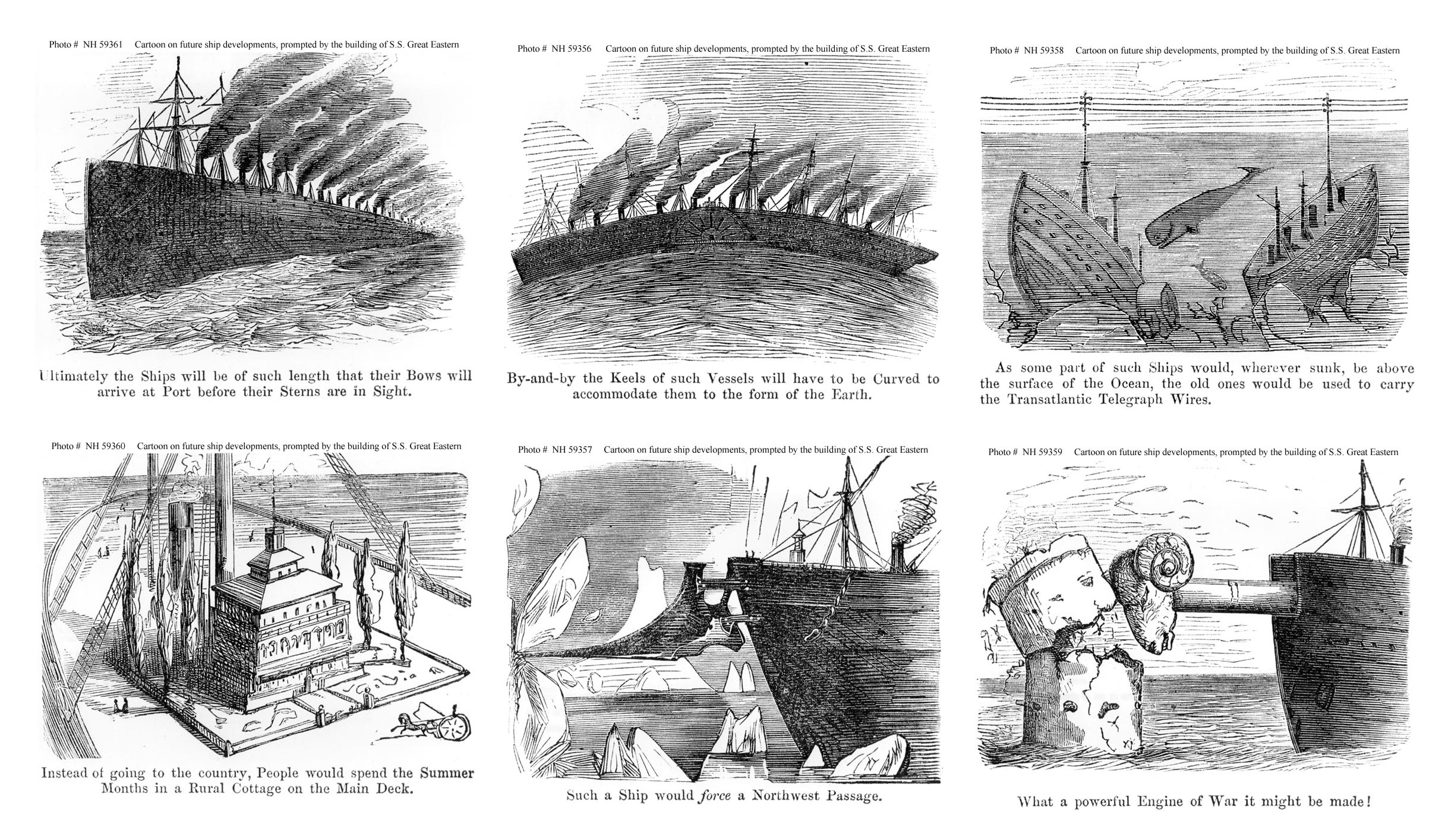
Figure 3: American cartoons from the time of the construction of GREAT EASTERN offered many possibilities for comparisons. 1) With the ports: predicting that when the bow of the ship arrive, the stern is not even visible on the horizon (top left). 2) With the Earth: drawing attention to the fact that the keel of such huge ships must already be curved in advance to conform to the curvature of the Earth's surface (above center). 3) With the depths of the seas: assuring readers that modern ships are now so large that some of their parts will necessarily rise above the water even if they sink, providing an excellent opportunity, among other things, to stretch the transatlantic telegraph cable between them (above right). 4) With a country cottage: indicating that if one wants a little relaxation, it is enough to ride a carriage out to the aft deck (bottom left). 5) With the icebergs: making sure that a ship of this size can even break through the ice barrikades of the Northwest Passage (bottom center). 6) With naval forts: drawing attention to the potential benefits of military use of such huge ships (bottom right). (Source: S.S. Great Eastern – Contemporary Cartoons inspired by the Ship, Department of the Navy, Naval Historical Center)
These depictions are rather funny and even mocking. The huge hull had not even been launched for three months, which gave enough reason to ridicule, saying why the ship was being built with a size that could not be moved. Nevertheless, these depictions, which in their day may have really made many people smile, foretold, in a strange way, almost visionarily, all that had finally happened:
1) GREAT EASTERN led to a huge business collapse, partly because there wasn’t a port all over the world that could serve the huge ship. The spectacular expansion of port infrastructures has begun in the world just because of the developments predicted by the ship.
2) Although ocean liners have never been able to grow large enough to traversed the Earth, the network of scheduled voyages performed by steam-powered ocean liners (which operated independently from the wind) created the opportunity for predictable, safe, and regular transcontinental transportation all over the planet.
3) After the bankruptcy of her operating company, first succesfull use of GREAT EASTERN became possible at the time of the laying the transatlantic telegraph cable between Europe and America. This work would have been impossible without the high-capacity vessel, which could have taken on board at once the entire amount of cable long enought for the distance between the two continents.
4) The depiction of a palace-like summer residence on the aft deck also foreshadowed the future which baceam reality later, as the huge ocean liners were not only built large, strong, and fast, but also equipped with the amenities that passengers were accustomed to on land and demanded at sea. Verne’s “floating city” was only referring to the wast number of people who could be taken on board. However, it soon became apparent that the people in this "city" could access almost all the services which alvailable too for them in towns in their homeland. What’s more, it also turned out that the rooms used to accommodate first-class travelers rival the lavish furnishings of an aristocratic residence or a first-class hotel. The former “floating cities” then became “floating palaces” as well.
5) In retrospect, the mention of ice is also astonishing. Although there have been ice-related shipwrecks until then, no one has assumed that huge ships like the GREAT EASTERN could become victims of such accidents. Moreover, in truth, no one believed that waves of the high seas could be seriously felt by those who were on board a ship of this size (until the GREAT EASTERN’s swaying in a strong storm proved otherwise, deterring passengers for a long time). Disaster of the TITANIC, which collided with an iceberg and sunk, shaken the confidence for invulnerability of such a huge ships, and warned greater caution in design, construction, and operation.
6) Finally, a prediction related to the military use of ocean liners was confirmed too: the strong and fast ships with a huge capacity, able to keep the schedule in spite of the weather, were frequently used for carrying troops across the ocean. They have appeared in various conflicts of the British Empire from South Africa to India and China. They fought in the Spanish-American colonial war, in the First and Second World Wars, and even in the Korean War. Their significance is well illustrated by the fact that the ocean liners QUEEN MARY and QUEEN ELIZABETH carried a total of 2,200,000 troops between 1940 and 1945, shortening World War II by two years, according to Winston Churchill.
The fortune-telling of the cartoons is no wonder, as the GREAT EASTERN was the messenger of the future. Messenger of the Distant Future: The revolutionary innovations of its designer and builders were so ahead of their time that for 40 years, no ship was built that could even approach the dimensions of her. The first ocean liner, which was longer than her, was built in 1898 (R.M.S. OCEANIC II), the first to have a larger displacement, though only in 1901 (R.M.S. CELTIC). All this led almost naturally to the fact that in the nineteenth and in the twentieth century, almost every new ship was somehow compared to the GREAT EASTERN, as both their designers and builders measured their own performance against the results of their great predecessors. In fact, this gave birth to the graphic genre of comparisons, which has remained essentially unchanged to this day.
Figure 4: Comparing the length of the GREAT EASTERN (1858) and the OCEANIC II. (1898) from 1899. The Harland & Wolff Shipyard in Belfast, which designed and built OCEANIC II, and the owner White Star Line, were proud to announce that they firstly performed that, what could not succeed for anybody in the last forty years: for the first time, they surpassed the majestic GREAT EASTERN with a ship which could be operated economically. (Source: „Scientific American” 1900. March 31.)
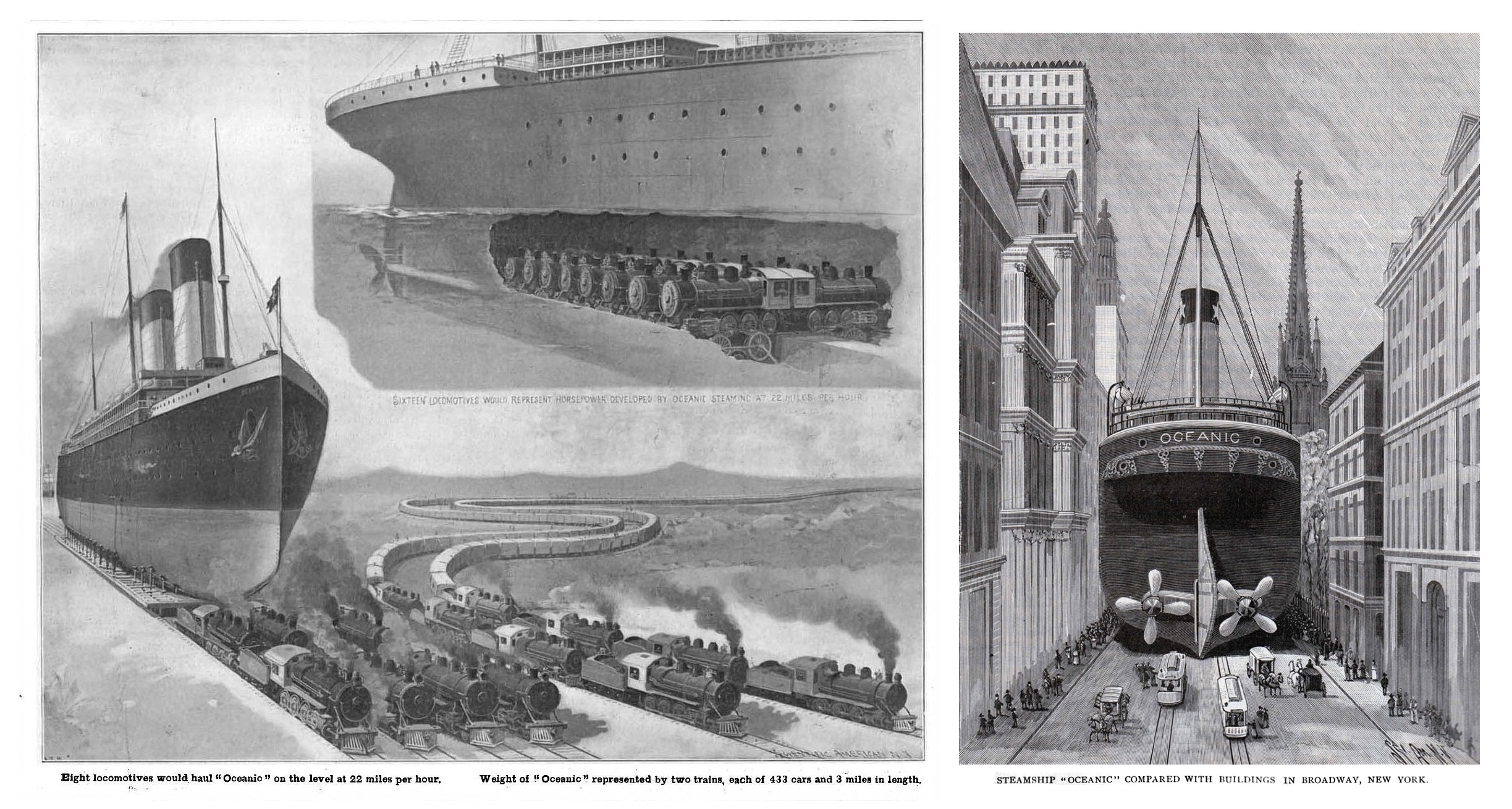
Figure 5: Engines and power of the OCEANIC II. The caption for the images is, "Sixteen locomotives would present horsepower developed by OCEANIC steamship steamed at 22 miles per hour." "Eight locomotives would haul OCEANIC on the level at 22 miles per hour." "Weight of OCEANIC represented by two trains, each of 433 cars and 3 miles in length." (Source: „Scientific American” 1900. March 31.)
II.) Comparisons as a means of advertising - the spread and main types of representation:
After esurpassing the GREAT EASTERN (greatest technical achievement that seems unsurpassed for four decades) the potential for advertising in comparisons has already become a "weapon" in the arsenal of commercial “war”, in the competition between the creators of new and even newer shiping wonders. Due to this, the useage of comparative information graphics which used to make the extraordinary capacity of ocean-going vessels widely known, was already a common advertising ploy in the second half of the 19thcentury. They no longer primarily compared the ocean liners to GREAT EASTERN, but rather to each other. It was also common practice to compare the size of the new ocean liners with the known large-scale structures and monuments of the age - Egyptian pyramids, American skyscrapers, possibly different parts of the city - or with famous ships of previous eras instead of contemporary liners, thus illustrating the change, technical progress and engineering excellence. The pictures, which were meant to be impressive, were expected not only to awaken general enthusiasm, but also to gain the very specific interest and trust of those preparing to travel overseas in the purchase of tickets.
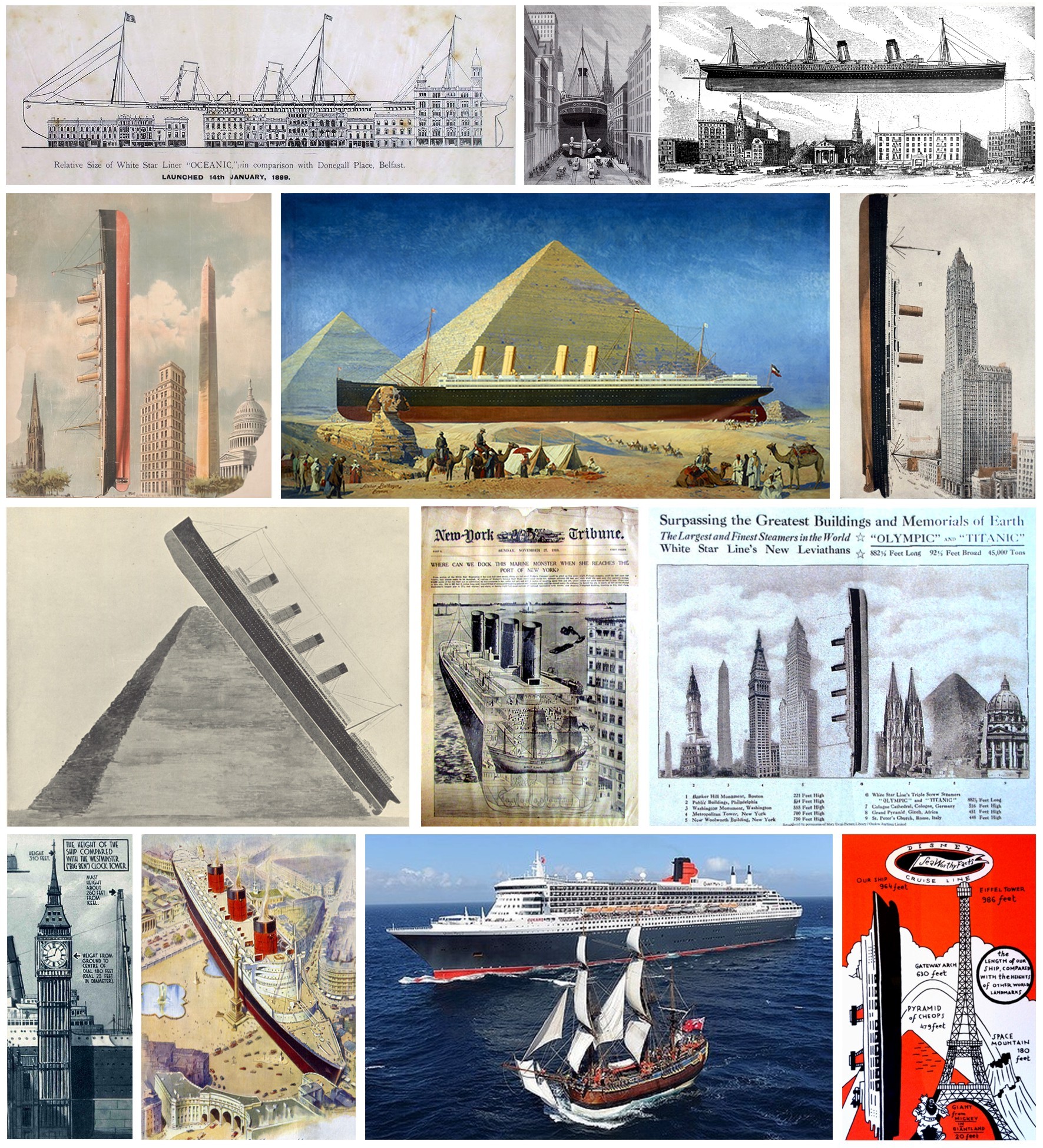
Figure 6: OCEANIC II (in the top row). KAISER WILHELM der GROßE, KAISER WILHELM II and IMPERATOR (in the second row). LUSITANIA, OLYMPIC and TITANIC (in the third row). QUEEN MARY, QUEEN MARY II, and DISNEY (in the bottom row). (Source: Private Collection of Dr. Tamás Balogh, Library of Congress, Mariner's Museum, New York Tribnune November 27., 1910., and other sources and collections).
II.1. Comparison of liners to each other: While the English often compared their ships to each other (makte the continuous improvement perceptible by this way), the German companies — emphasizing sheer size primarily — compared their oceanliners to buildings (perhaps because the German is traditionally a land-based rather than a seafaring nation).

Figure 7: Representation of the size of British ocean liners compared to other vessels (Source).
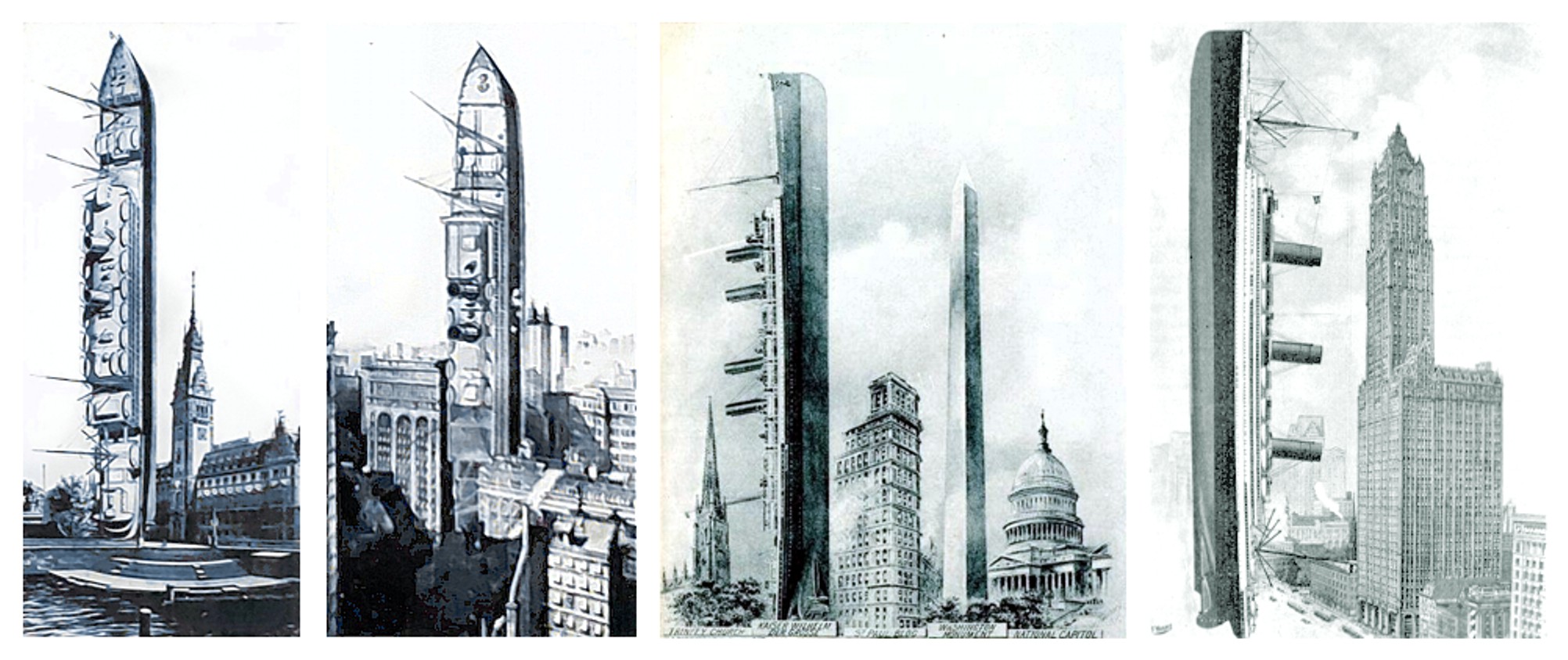
Figure 8: German ocean liners in the urban skyline: 1) the s.s. AMERIKA (1905-1957) with Hamburg City Hall. 2) The s.s. KAISERIN AUGUSTE VICTOIRIA (1905-1930) with Park Row Building in New York. 3) The s.s. KIASER WILHELM der GROßE (1897-1914) next to the Trinity Church in Manhattan, the Saint Paul Building in New York (1895-1958), and the obelisk of the Washington Monument and the dome of the Capitol in Washington DC. 4) Finally, the s.s. IMPREATOR (1912-1946) next to the Woolworth Building in New York. (Source)
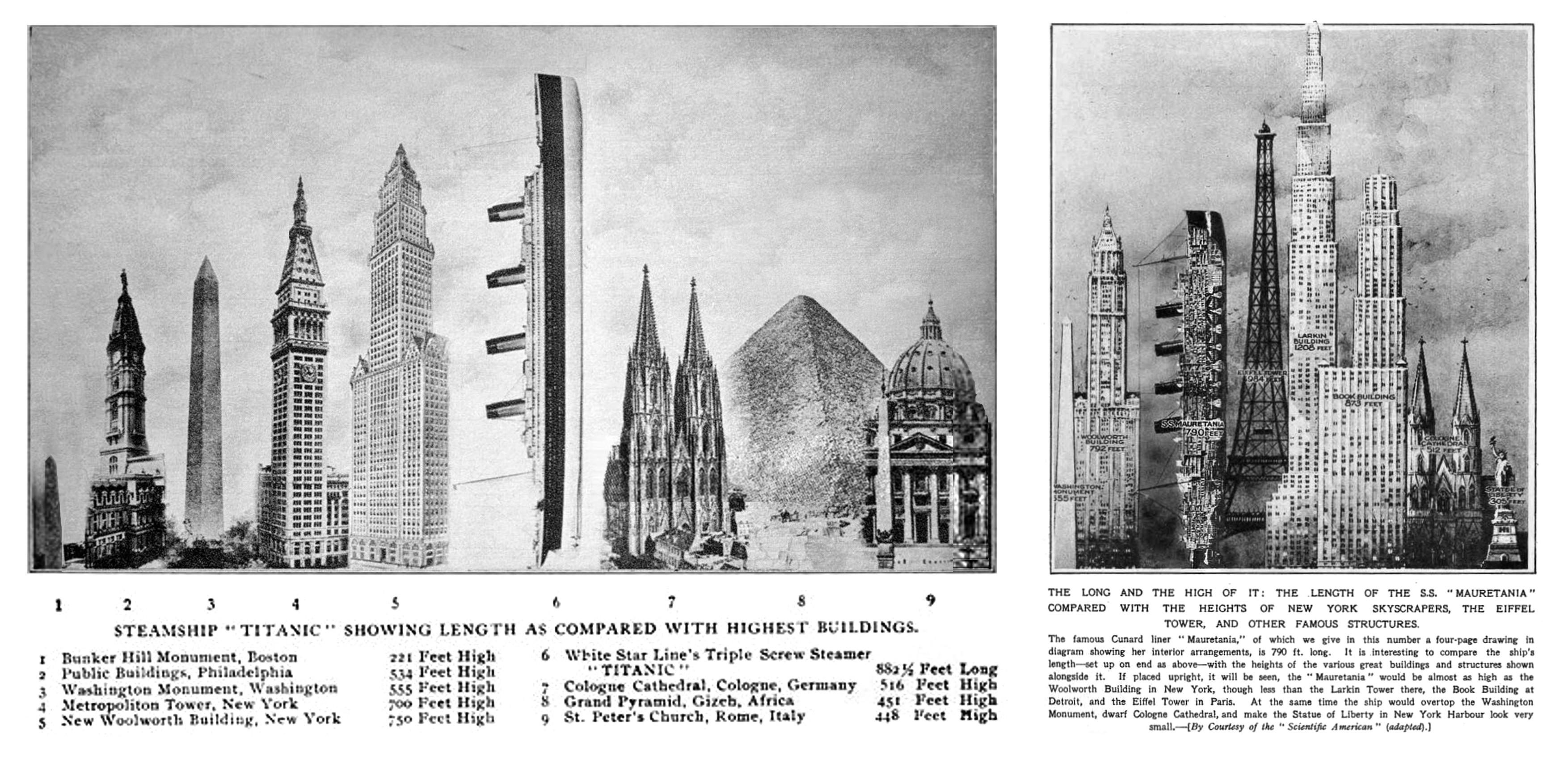
Figure 9: British ocean liners in the urban skyline - TITANIC and MAURETANIA: In addition to the TITANIC: 1) the Bunker Hill Memorial in Boston, 2) the Public Building in Philadelphia, 3) the Washington Monument, and 4) the Metropolitan Tower in New York, 5) and the Woolworth Building, 6) the Cologne Cathedral, 7) the Great Pyramid of Gizeh, 8) the St. Peter’s Basilica in Rome. The iconography of the image is also eloquent: the sights of the Old and New Worlds are connected by the oceanliner. This well-known poster was designed by Jay Henry Mowbray, originally for the R.M.S. OLYMPIC. It was later used for the advertising of the R.M.S. TITANIC as well, but not for the H.M.H.S. BRITANNIC (ex-R.M.S. GIGANTIC). The picture about the lenght of the R.M.S. MAURETANIA compared with the heights of New York Skyscrapers, the Eiffel Tower and other famous structures appeared in the journal "Scientific American" in the 1920s. (Source)
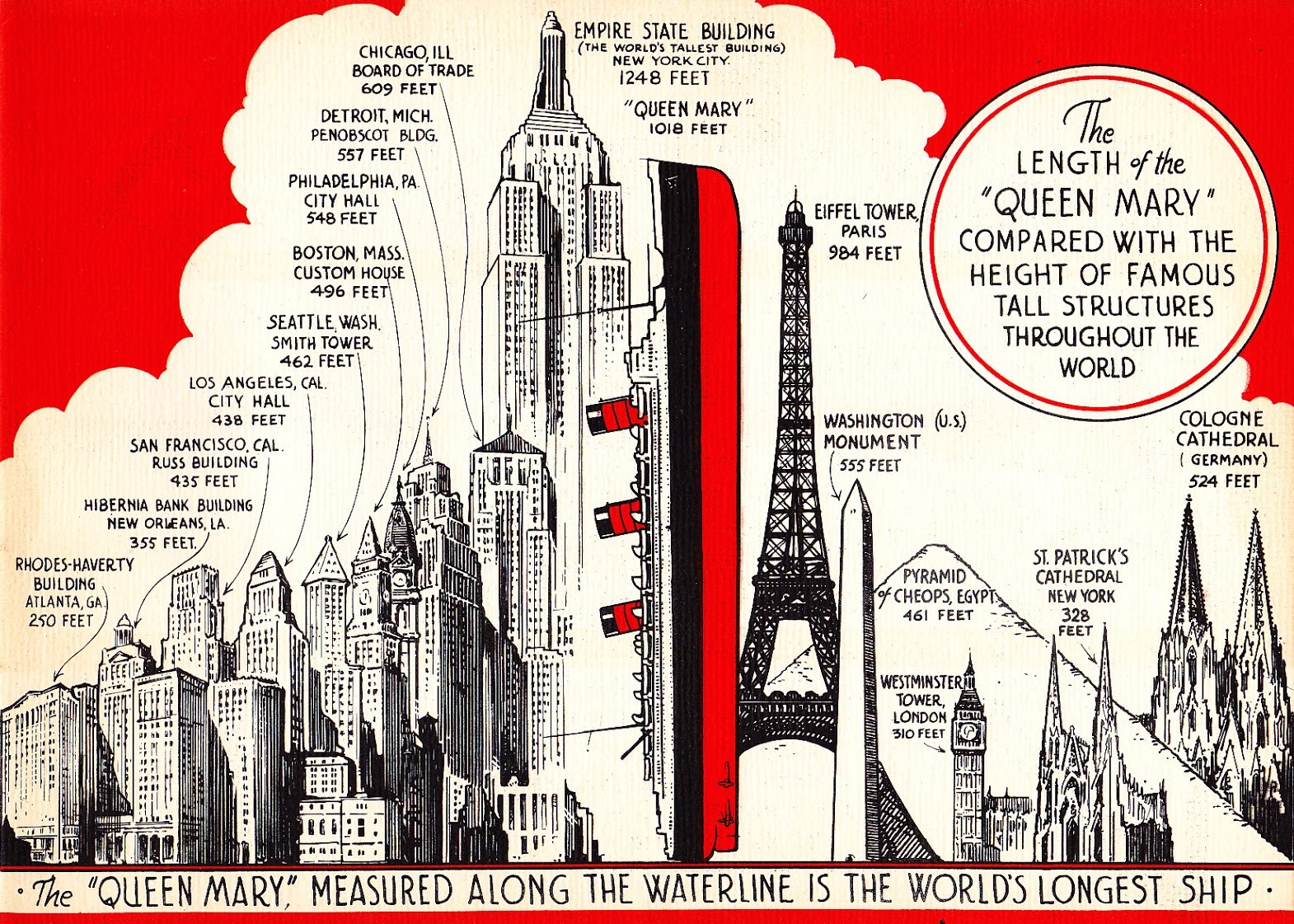
Figure 10: The ocean liner QUEEN MARY and the wonders of the Old and New Worlds. The picture clearly shows the effect of TITANIC's similar advertising (Source).
With the development of marketing, the way of representation has also changed. Poster-like representations (possibly reproduced on postcards) highlighting the characteristic features of ocean liners were replaced in the years immediately prior to the First World War by thematic brochures sold in gift shops of ships and companies, which offered the possibility of comparison in various respects.
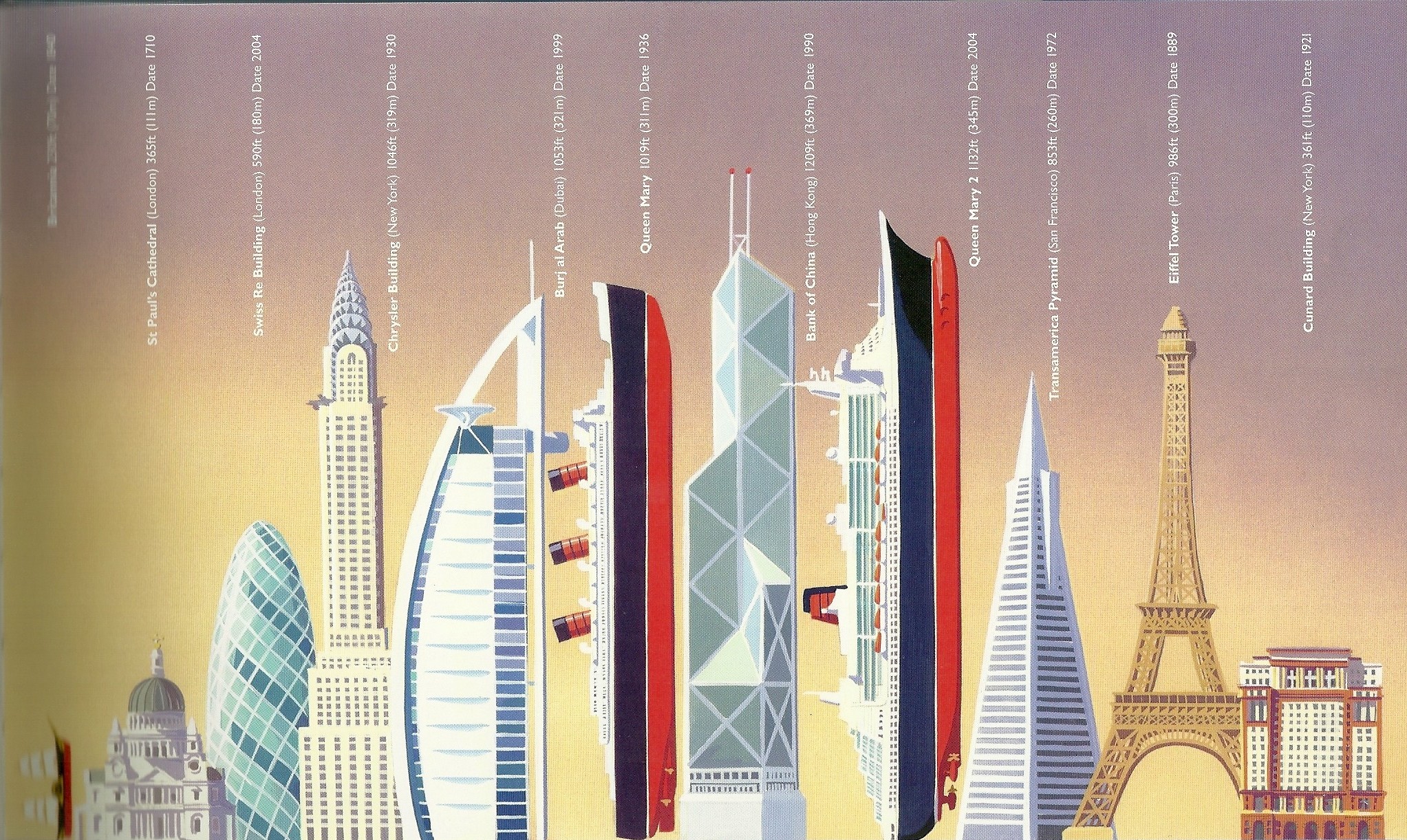
Figure 11: The legacy of QUEEN MARY. In this comparison, which depicts the lenght of the ocean liner QUEEN MARY II., the influence of the TITANIC advertising previously seen is clearly identifyable (although this image, like the MAURETANIA advertising, shows buildings from different parts of the world). (Source)
II.2. Comparison of liners to buildings and monuments: A typical example of German practice comparing ships to buildings is the comparison of the s.s. KAISER WILHELM II. (1902-1940), the latest ocenliner (together with her sister) equipped with reciprocating steam-engines. Using the series of comparison drawings made for domestic “consumption” (also reproduced on postcards), every German person could easily have an idea of the dimensions of the ship by comparing her with the well-known cities of their hometown.
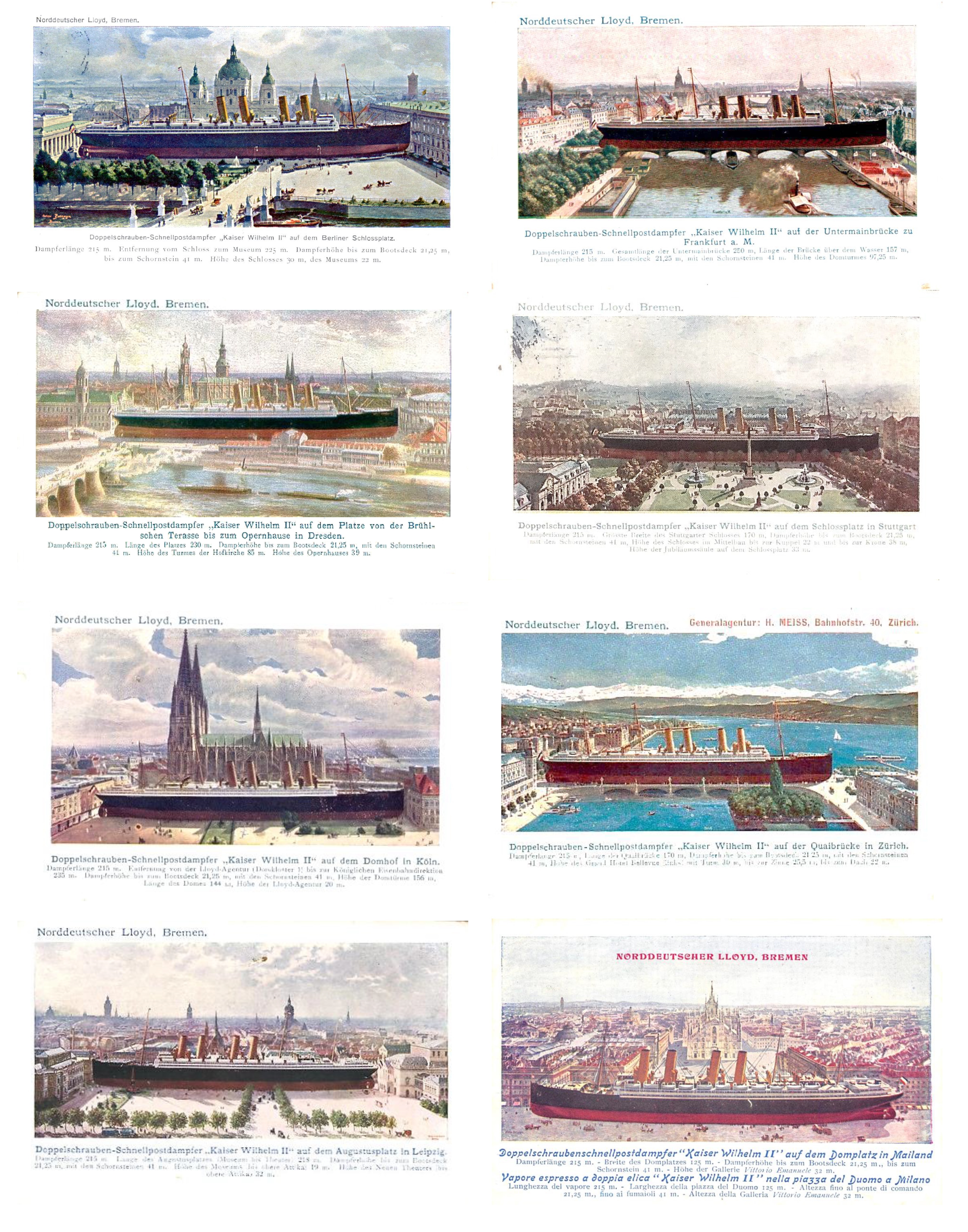
Figure 12: German comparisons - the s.s. KAISER WILHELM II. in various German and other European cities (Sources: 1., 2., 3., 4., 5., 6., 7. 8.).
Interestingly, this mode of representation survived until the outbreak of World War II and in case of several German ocean liners it was also used for - e.g. in case of ALBERT BALLIN (1922-1945) and COLUMBUS (1922-1939).
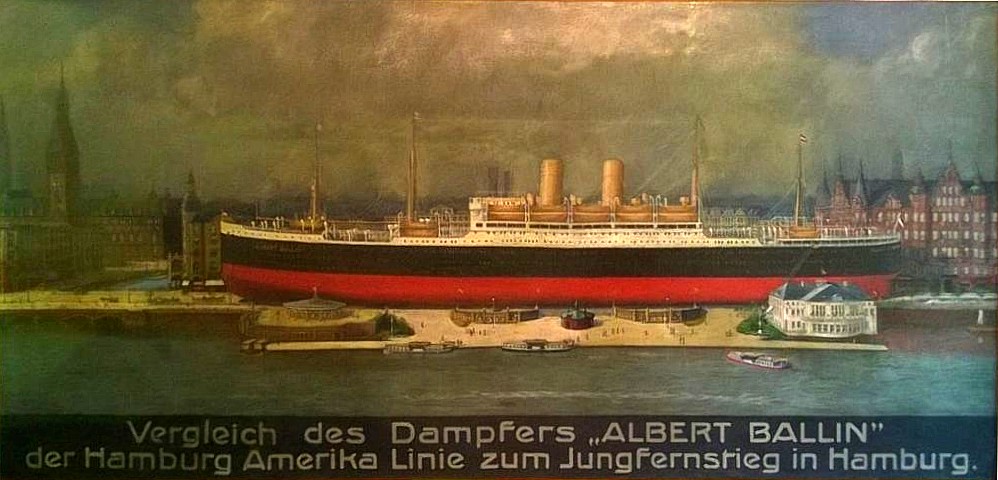
Figure 13: The German pre-World War I. comparing practice, also applied in case of the s.s. ALBERT BALLIN of the famous HAPAG shipping company (that was the first German ocean liner which built after the war) . This picture depicts the ship on the Jungferstieg, famous riverside promenade of Hamburg, situated in the a historic core of the city from the Hanseatic periode. (Source)
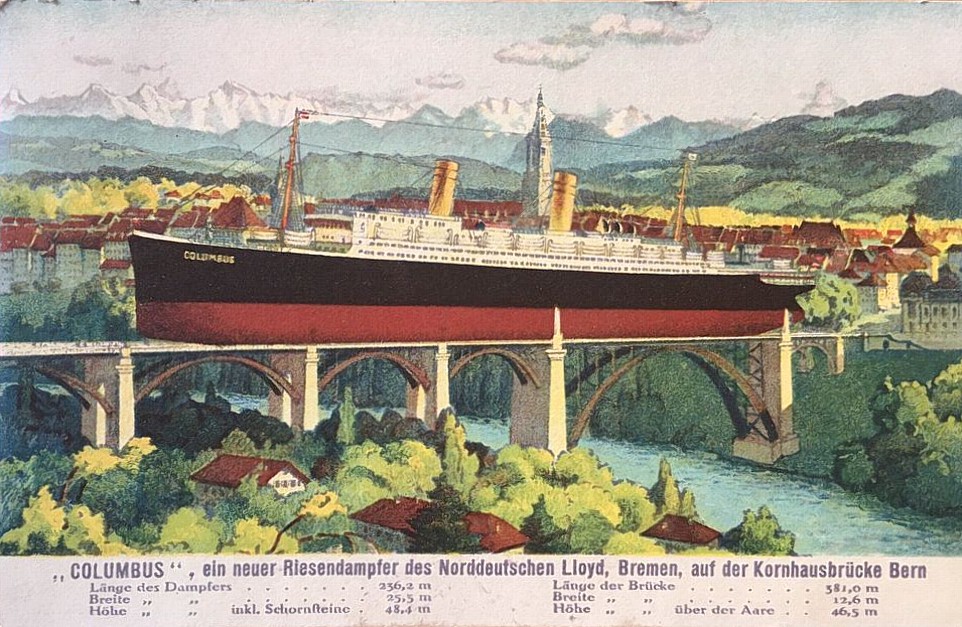
Figure 14: A comparative figure showing the dimensions of the COLUMBUS, the largest German ocean liner in 1924, depicting the ship in the traditional way, placed on the Kornhaus bridge in Bern, showing its length. (Source)
II.3. Comparison of liners to famous historic vessels, like SANTA MARIA, etc.: A common example of a comparison to famous historic ships is a comparative representation between a certain ocean liner and the SANTA MARIA, world-famous ship of Columbus. In these cases, when it was enough to highlight only one aspect in the comparison, there was an opportunity to make the representation more demanding, sometimes artistic. This is the case for the british-built Spanish ocean liner ALFONSO XIII (1888-1915), which was commissioned by its proud owner, Compagñia Transatlantica Española, in which the liner was painted together with the sailing vessel of the 15th century.
The theme also returned when the s.s. COLUMBUS departed to her first voyage in 1924. The sameness of digits in the number-sequence representing the years of 1492 and 1924, and the spectacular difference in size between the ships of the two voyages of that years was used in order to celebrate the commissioning of the greatest German ocean liner built until that after World War I. SANTA MARIA also appears in a brochure published on the occasion of the 1936 inaugural voyage of the British ocean liner QUEEN MARY, in which a whole range of technical characteristics of the ship have already been illustrated with the help of spectacular comparative figures.
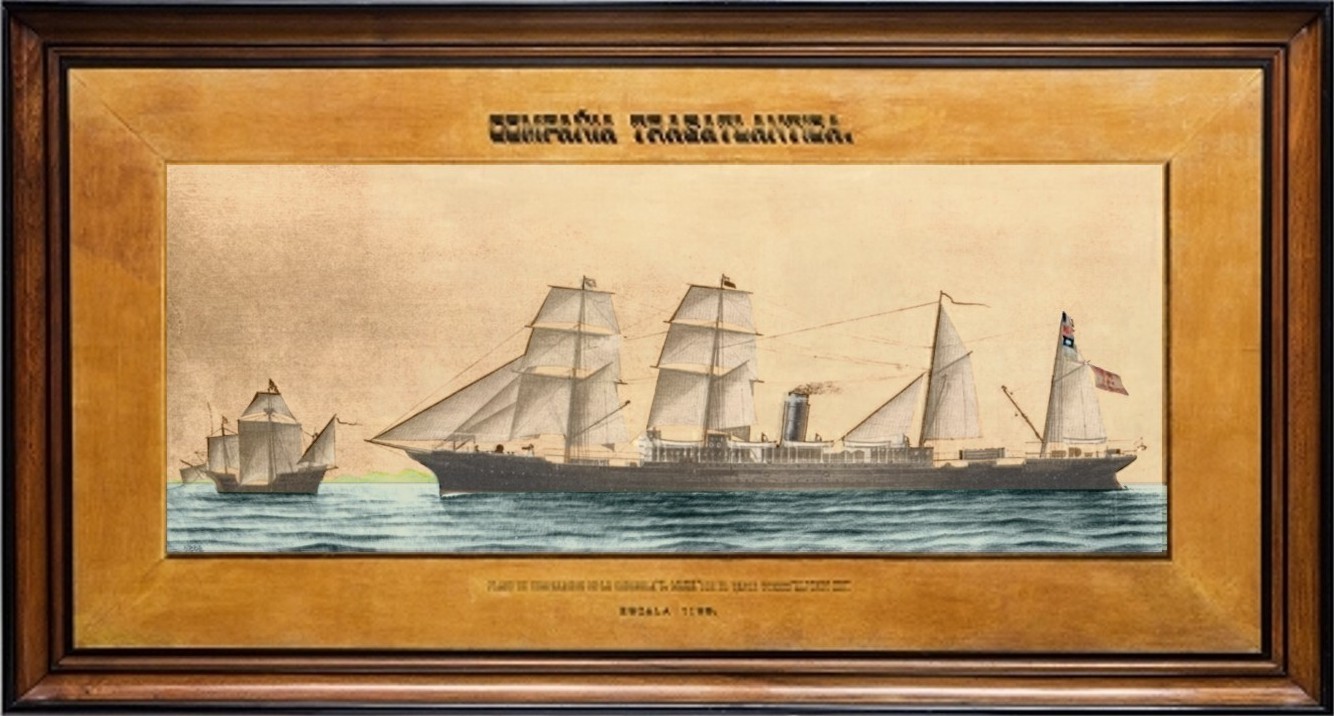
Figure 15: A 1888 painting depicting a comparison of the Spanish ocean liner ALFONSO XIII and the caravela SANTA MARIA (painter: unknown). (Source)

Figure 16: A 1924 painting depicting a comparison between the German ocean liner COLUMBUS and the caravela SANTA MARIA (artist: Hans Bohrdt). (Source)

Figure 17: Ships of Columbus also appears alongside the R.M.S. QUEEN MARY (latest Cunard liner) which escorted by R.M.S. BRITANNIA (the first ship of the Cunard Line) in the comparison-booklet made for the inauguration voyage of the Cunard Queen (Source).
A fine example of a comparison with historic ships is the 1920 billboard reviewing the three-hundred-year development of trans-oceanic passenger transportation, which compares the ocean liner R.M.S. AQUITANIA (1913-1950) with the galeon MAYFLOWER (1620) and the steamer BRITANNIA (1840). The billboard shows the depicted ships as an exploded view, giving a glimpse into the interiors, emphasizing that technological advances have not only reduced the time required for the ocean crossing, but also significantly increased the comfort and the number of passengers that can be carried.

Figure 18: Three hundred years of development of trans-oceanic passenger transport, 1620-1920 (Source: Cecil J Allen, John R Hind: My Book of Ships, 1920.).
The period between the two world wars has other interesting things, as British shipping companies increased their advertising activities in the Central European region, where after the collapse of the Austro-Hungarian Monarchy and its shipping it was possible to travel only on ships of foreign companies. As the region was previously dominated by German cultural influence, the British White Star Line also illustrated the dimensions of its ocean liners for those living in the successor states of the Monarchy with German-patterned comparisons comparing ships to well-known buildings.
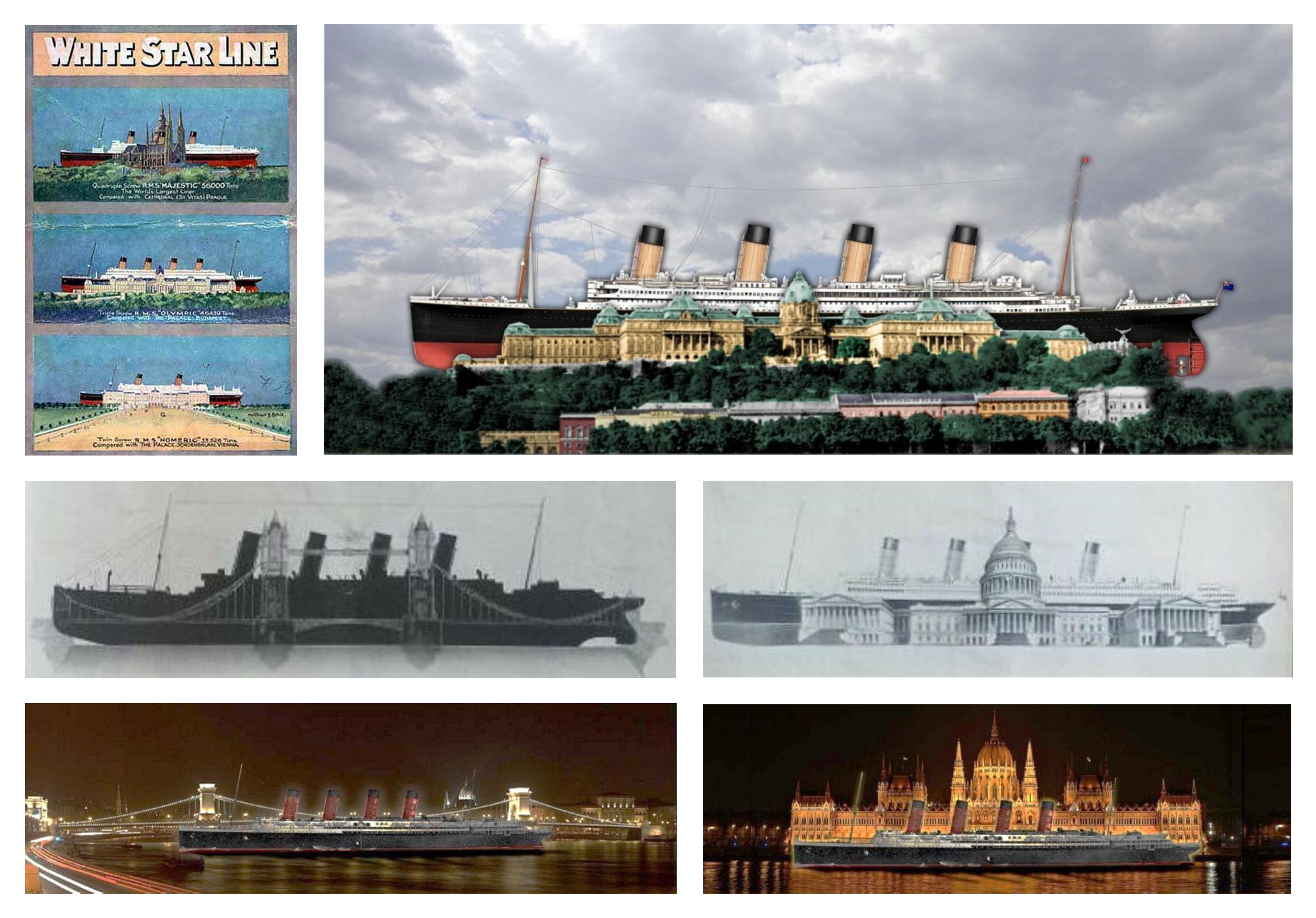
Figures 19.-20., 21.-22., and 23.-24.: Representations and modern counterparts of the period between the two world wars: To the left above: the MAJESTIC (1914-1943) and St. Vitus Cathedral in Prague, the OLYMPIC (1910-1935) and the Royal Palace in Buda, HOMERIC (1913-1938) and Schönbrunn in Vienna. To the right above is the modern comparisons of the R.M.S. TITANIC with the Royal Palace of Buda (Source: Dr. Tamás Balogh). In the center row there is a comparisonof the R.M.S. AQUITANIA with the Tower Bridge, London (left) and with the Capitol Building in Washington D.C. (right). In the bottom row there are some modern counterparts: the comparison of the R.M.S: LUSITANIA with the Chain Bridge (left) and the Parliament House (right) of Budapest (Source: Dr. Tamás Balogh).
III. Special comparisons:
Outstanding types of comparative drawings are those that illustrate the amount of resources required to operate ocean liners in such spectacular grouping that enchantes the readers. These representations are also exceptional because after the proliferation of thematic brochures, it was no longer necessary to carry out the task of representation in a single image, as each comparisons-booklet contained a separate illustration for each characteristic. Therefore, that graphic representations made in the earlier period are so important, since they sought to display as many features as possible in a single picture. These includes American infographics of the ocean liners s.s. DEUTSCHLAND (1900-1925), and R.M.S. TITANIC (1911-1912).
The comparison of DEUTSCHLAND shows the huge amount of provisions needed to suplly the ship. This revealed that the supply of 1 100 passengers on board during the five-day Atlantic crossing required 6,000 lbs (2,800 kg) of poultry-games, 1,200 lbs (550 kg) of lamb, 2,200 lbs (1,000 kg) of mutton, 13,000 lbs (6,000 kg) of beef, 1,200 lbs (550 kg) of veal, 900 lbs (400 kg) of pork (+ 600 lbs - 300 kg - ham). In addition, 400 tons of drinking water and 40 tons of ice, 3,000 bottles and 375 barrels of beer, 2,200 gallons (9,900 liters) of milk, 300 gallons (1,350 liters) of cream, 1,200 pounds (550 kg) of butter, 1,700 boxes of eggs , 350 pounds (160 kg) of yeast, 175 barrels of potatoes, tomatoes and vegetables, 8,500 lbs (3,900 kg) of fresh fruit, 14 barrels of oysters and mussels, 1,700 lbs (770 kg) of fish and 1,000 bricks (1,400 liters ) ice cream and brought 5,000 tonnes of coal to supply the ship.
In contrast, the comparison drawing of the TITANIC is one of the few similar depictions of the ship made before its sinking. Its main theme is the presentation of the extraordinary dimensions of the ocean liner that need to be redesigned all harbour infrastructure in New York. From pre-disaster times, we know only a few depiction that was born overseas specifically to promote the TITANIC, along with symbols tailored to the tastes of American public (including famous American ships). This comparison drawing proudly proclaimed that the hull of the TITANIC would fit across by the HALF MOON of 1609 (famous ship of Henry Hudson, who discovered the mouth of the Hudson River in Dutch service), or that 28 copies of the s.s. CLERMONT of 1807 (the very first steamer, constructed by Robert Fulton), would be needed to cover the full length of the boat deck, which is so long that it could comfortably would fit together with an average locomotive with coal carriage and eight Pullmann type railcars. And the ship — from the keel to the top of the four giant funnels — is ten times as tall as the New York Post and Telegraph Office building.
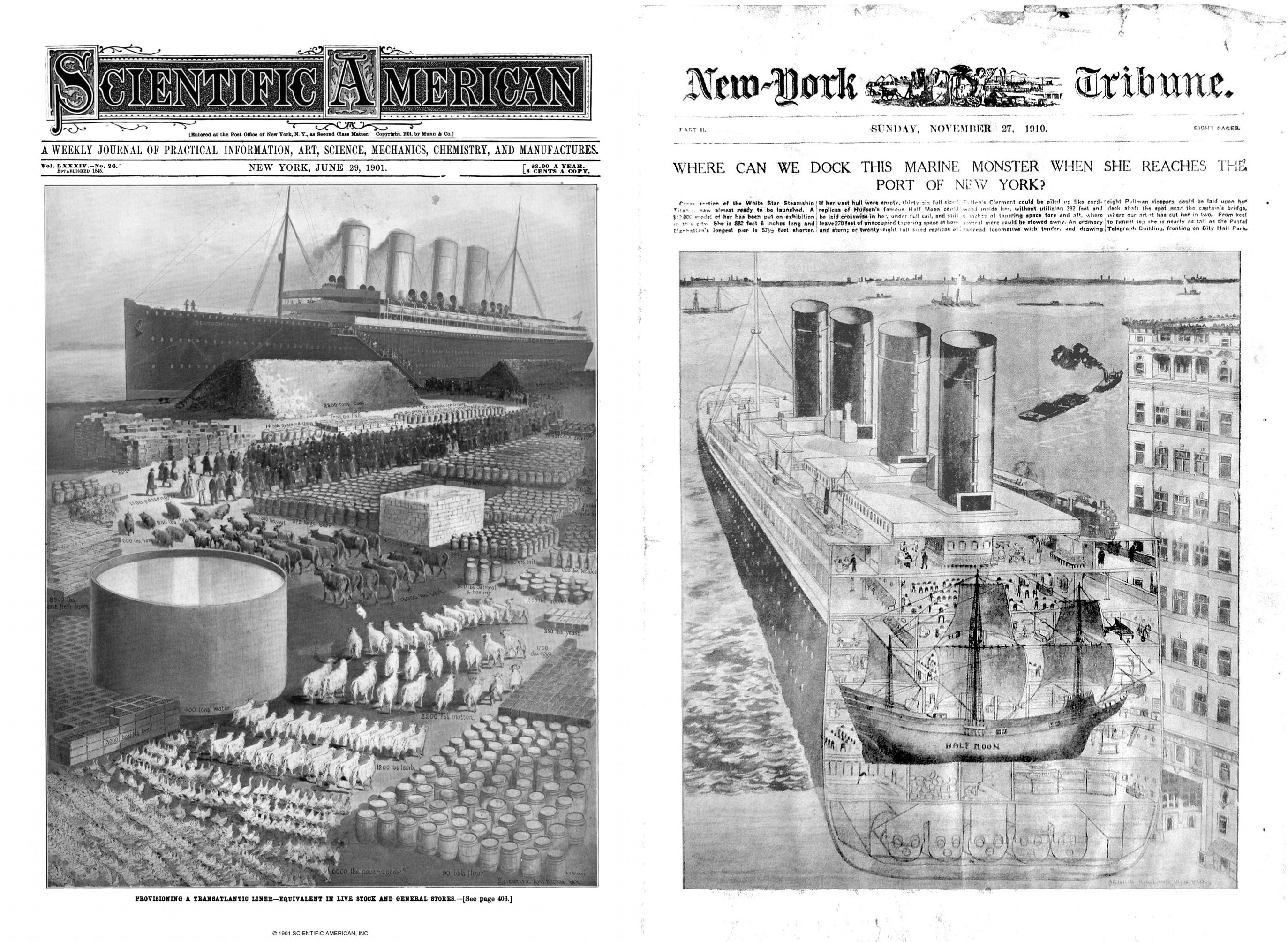
Figures 25, 26: Provisions for s.s. DEUTSCHLAND (left), and dimensions of the R.M.S. TITANIC (right). (Sorces: Scientific American, 1901. June 29., New York Tribune, 1910. November 27.)
IV.) Today's application of ocean liner comparisons:
When the ocean liner QUEEN MARY II. was launched in 2003, Cunard Line ordered a representative comparisons booklet which contained the same or very similar graphics as those were in the brochure which published when Queen Mary was launched in 1936. The new ship was inserted in place of the old in the 2003 brochure, so the new Queen could be the successor of her famous predecessor in those iconic depictions as well (see Figure 11). With that, ocean liner comparisons returned. After all, following the success of the publication, shipping companies operating liners and cruise ships have once again begun to see a fantasy in the sale of comparison booklets advertising the size of their ships, just as they did in the early 1900s.

Figures 27, 28 and 29, 30: Above is a comparative diagram of QUEEN MARY and Hercules H-4 (1947), Howard Hughes' giant seaplane called “Spruce Goose” (Source), and modern equivalent in which QUEEN MARY II can be seen in the background of an Airbus A-380 (2005) aircraft, the world’s current largest passenger aircraft (Source). Below is a comparison of QUEEN MARY, QUEEN ELIZABETH 2 and QUEEN MARY II (left), and TITANIC and QUEEN MARY II (right). The latter figure also appears in the company of the A-380, a bus, a car and a pedestrian.
It is striking in the new representations that TITANIC has now taken over the role previously held by GREAT EASTERN: a well-known and interesting icon in the history of shipping and technology that almost all ships are now compared to it.

Figure 31: The development of shipbuilding over a hundred years is convincingly shown in the figure above: today’s largest ship has a displacement which almost five times bigger than a hundred years ago (OASIS weighed 220,000 tonnes and TITANIC’s 46,328 tonnes). (Source)
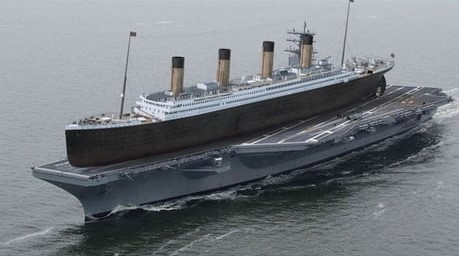
Figure 32: Spectacular comparison of TITANIC with the USS RONALD REAGAN (2001) nuclear-powered aircraft carrier of the US Navy. (Source)
In addition to the commercial use of the comparisons commissioned by shipping companies, other uses can be observed, namely in the communities of fans of ocean liners. Graphic artists sometimes make a modern copy or develpo further of a famous original comparison drawing to entertain themselves and other, which - thanks to modern digital graphic tools - enhances the visual experience of representation.

Figures 33 and 34: The sinking of TITANIC has been reported worldwide by the press. The illustrated magazines shown the magnitude of the disaster with spectacular drawings, comparing the dimensions of the ship to buildings familiar to their readers. A comparison drawing published in the April 19, 1912 issue of the French "Excelsior" magazine was then reproduced in the form of a postcard as well (top left). This was redrawn by Frenchman Cyril Codus and presented at the 2013 Paris premiere of TITANIC, Artifacts - The Exhibition. (Source)
Similarly, a comparison was made in 2016 comparing the dimensions of the ocean liner TITANIC and airship HINDENBURG, inspired by an eralier comparison drawing published in the August 1936 issue of the American “Popular Mechanics” magazine in which the airship was compared to the ocean liner QUEEN MARY.

Figures 35 and 36: Comparing the QEEN MARY and the TITANIC to the HINDENBURG (Source: Popular Mechanics, 1936. August). The airship drawn by Max Pinucci and the ocean liner by Michael Brady on the latter image (Source).
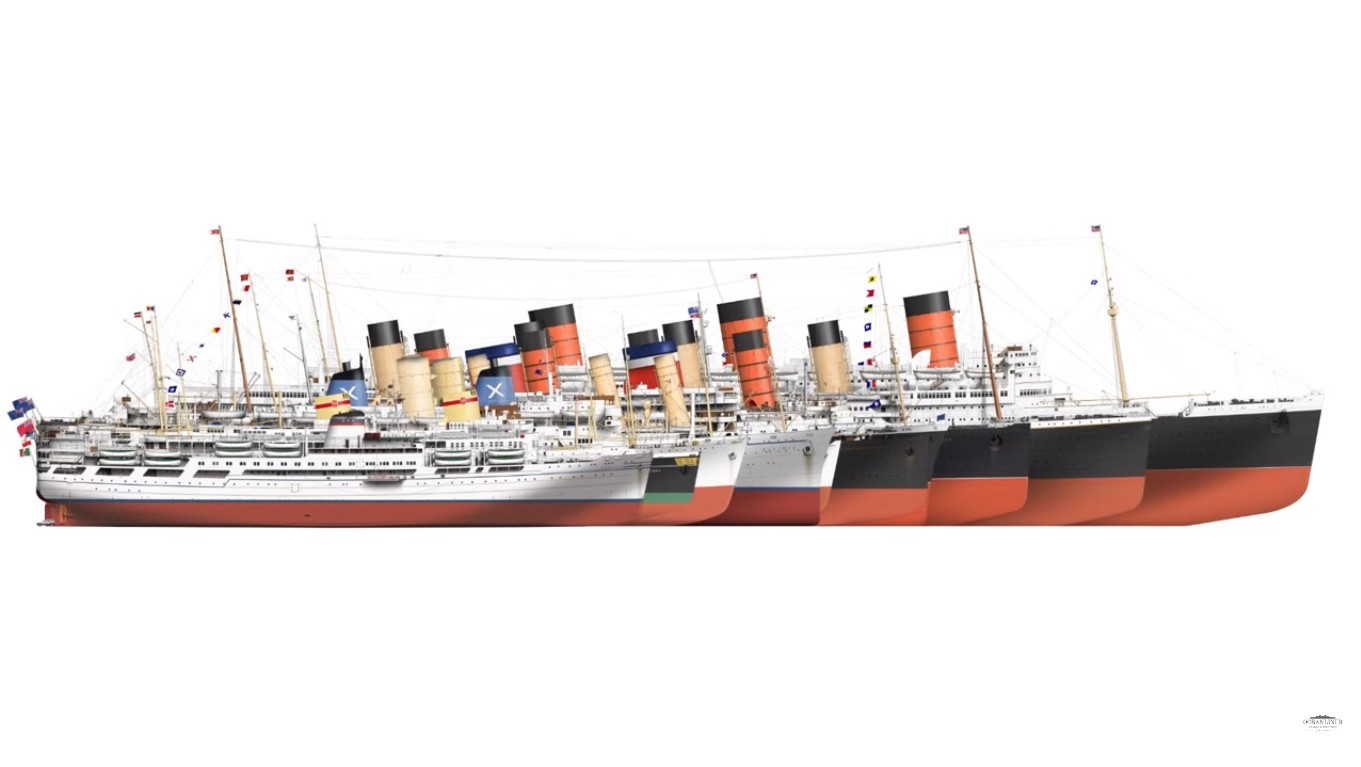
Figure 37: A fine example of modern digital comparative representations made by Michael Brady (Source)
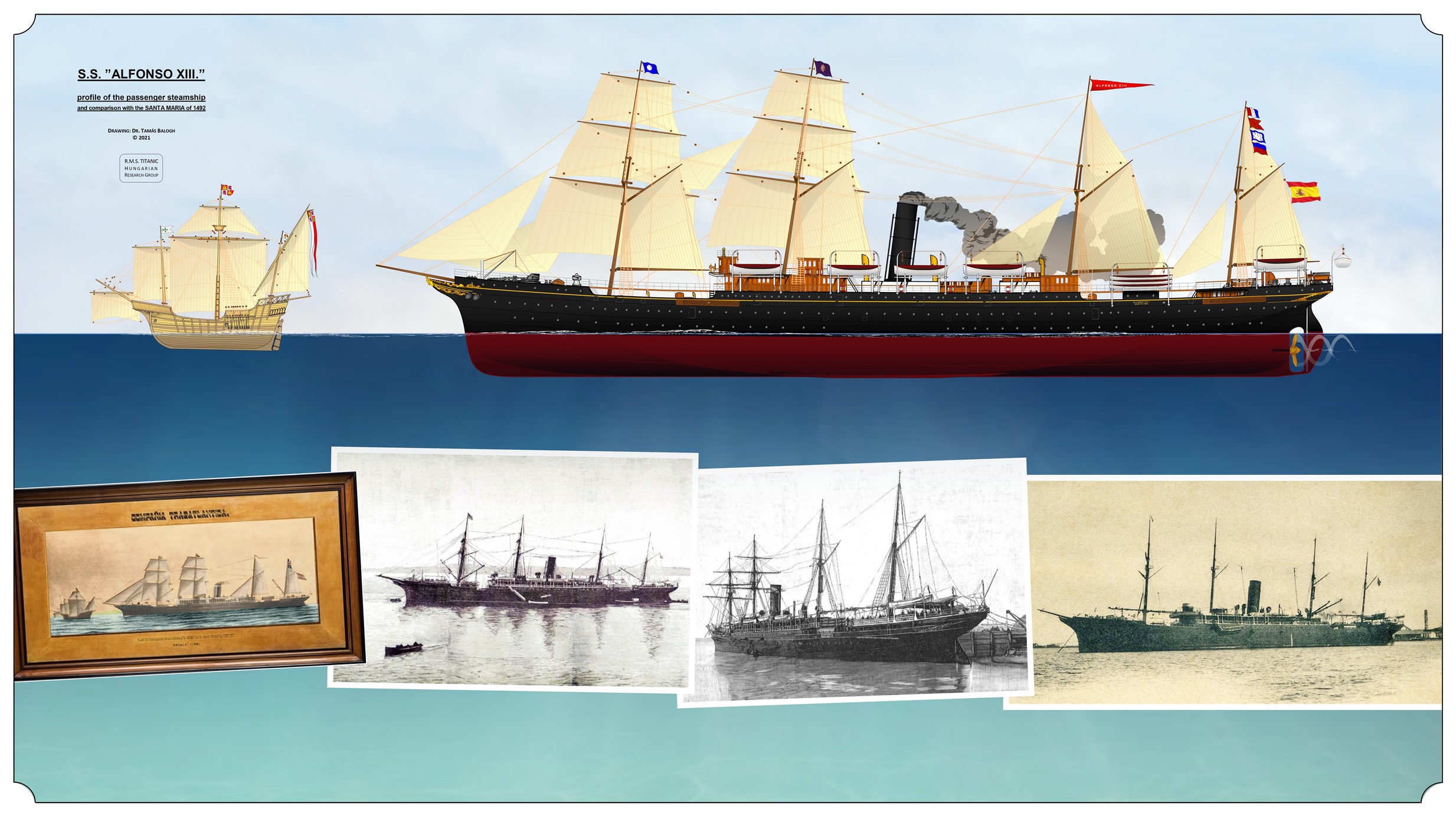
Figure 38: Profile drawings comparing different size of ocean liner ALFONSO XIII of 1888 and caravela SANTA MARIA of 1492, made after the original which made in 1888 (see Figure 15) and preserved in the Maritime Museum of Barcelona made by Dr. Tamás Balogh (Source).
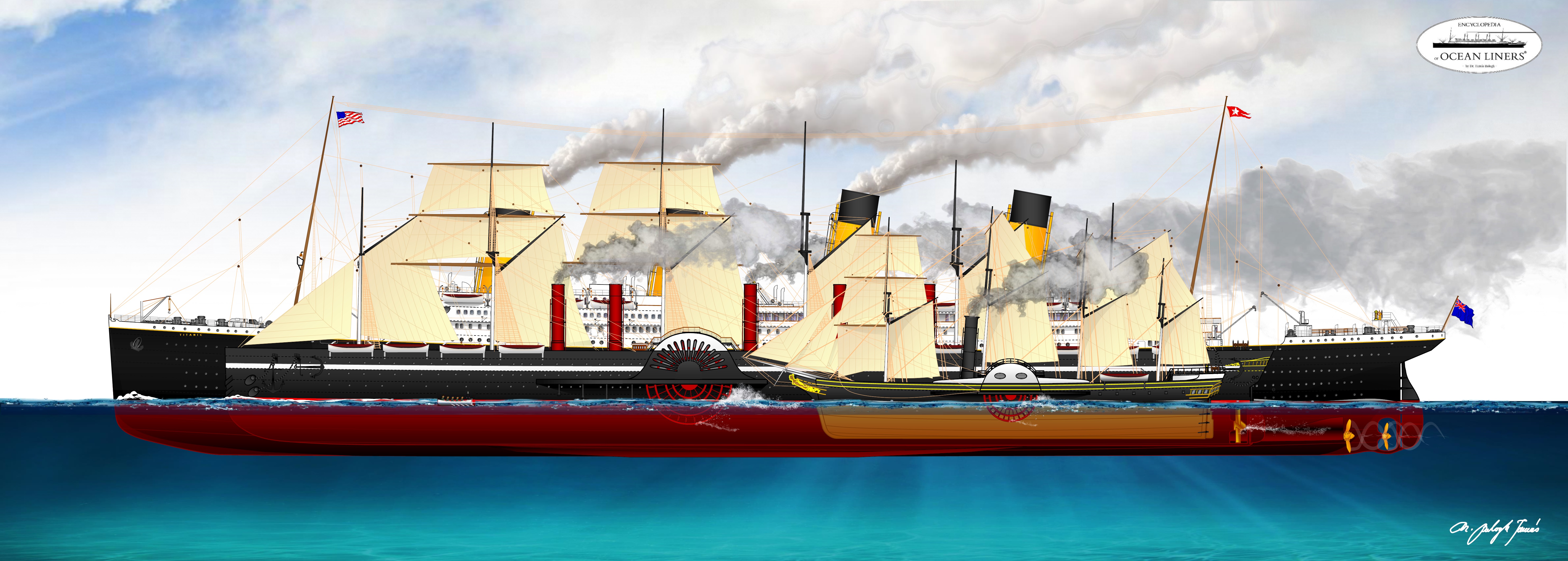
Figure 39: Appreciation. Comparing the dimensions of the s.s. GREAT WESTERN and the s.s. GREAT EASTERN - first and last ocean liners of Isambard Kingdom Brunel - and the R.M.S. TITANIC made by Dr. Tamás Balogh (Source).
Ocean liner comparison-drawings - surviving this way - can continue to fulfill their educational function and contribute to a better understanding of ocean liners by offering an interesting visual experience too at the same time.
It would be great if you like the article and pictures shared. If you are interested in the works of the author, you can find more information about the author and his work on the Encyclopedia of Ocean Liners Fb-page.
If you would like to share the pictures, please do so by always mentioning the artist's name in a credit in your posts. Thank You!
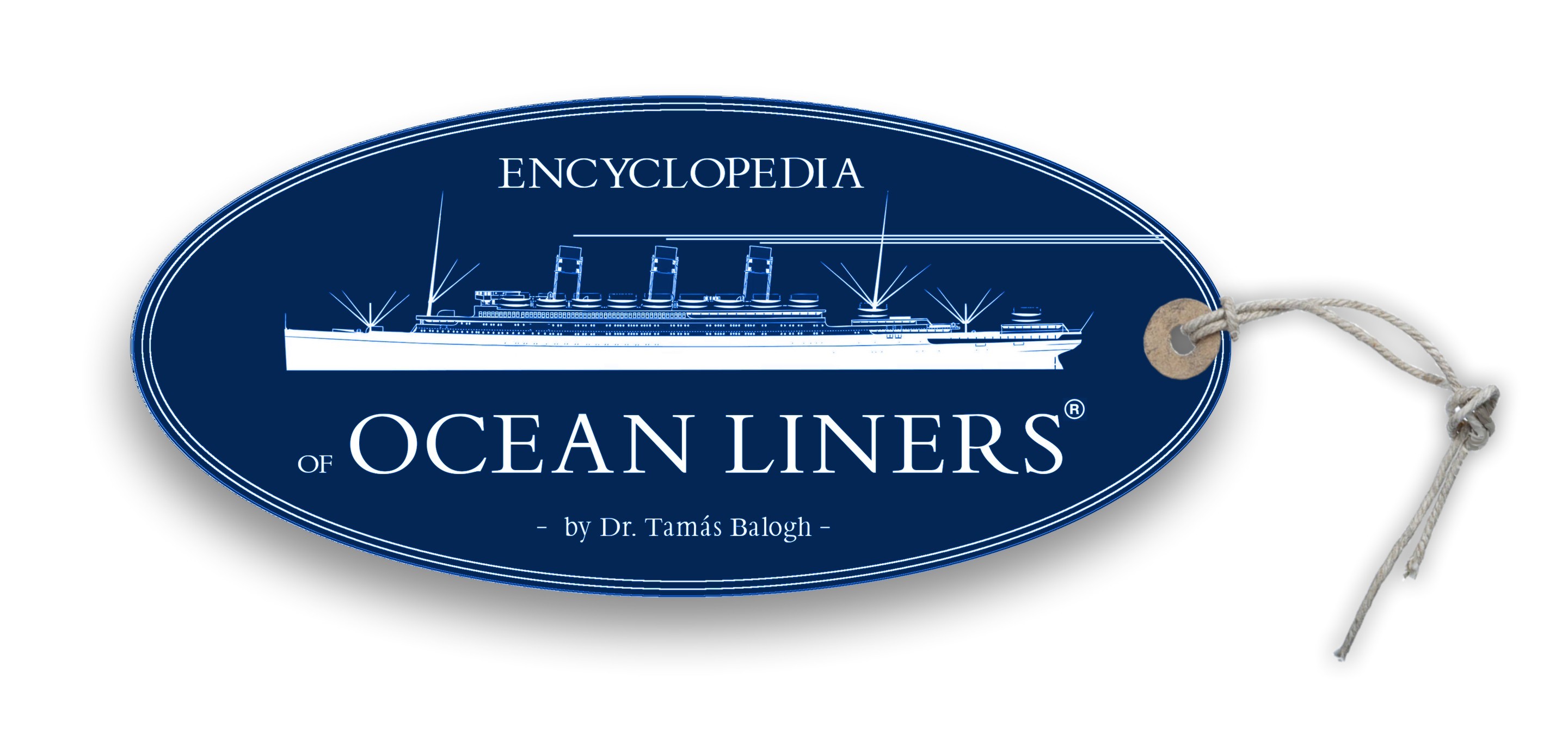


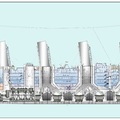
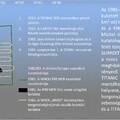

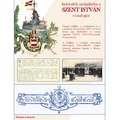
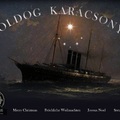
Utolsó kommentek